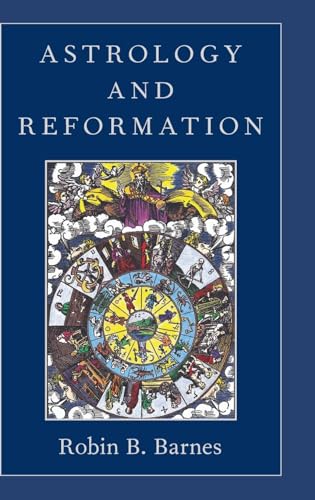Astrology and Reformation


sku: COM9780199736058NEW
ACCORDING TO OUR RECORDS THIS PRODUCT IS NOT AVAILABLE NOW
$101.05
Shipping from: Canada
Description
Winner of the 2016 Roland H. Bainton Book Prize of the Sixteenth Century Society and ConferenceDuring the sixteenth century, no part of the Christian West saw the development of a more powerful and pervasive astrological culture than the very home of the Reformation movement--the Protestant towns of the Holy Roman Empire. While most modern approaches to the religious and social reforms of that age give scant attention to cosmological preoccupations, Robin Barnes argues that astrological concepts and imagery played a key role in preparing the ground for the evangelical movement sparked by Martin Luther in the 1520s, as well as in shaping the distinctive characteristics of German evangelical culture over the following century. Spreading above all through cheap printed almanacs and prognostications, popular astrology functioned in paradoxical ways. It contributed to an enlarged and abstracted sense of the divine that led away from clericalism, sacramentalism, and the cult of the saints; at the same time, it sought to ground people more squarely in practical matters of daily life. The art gained unprecedented sanction from Luther's closest associate, Philipp Melanchthon, whose teachings influenced generations of preachers, physicians, schoolmasters, and literate layfolk. But the apocalyptic astrology that came to prevail among evangelicals involved a perpetuation, even a strengthening, of ties between faith and cosmology, which played out in beliefs about nature and natural signs that would later appear as rank superstitions. Not until the early seventeenth century did Luther's heirs experience a "crisis of piety" that forced preachers and stargazers to part ways. Astrology and Reformation illuminates an early modern outlook that was both practical and prophetic; a world that was neither traditionally enchanted nor rationally disenchanted, but quite different from the medieval world of perception it had displaced.
Price history chart & currency exchange rate
Customers also viewed

$7.30
Сладкий и минималистичный стиль, плетеный браслет для пары в форме сердца, милый плетеный браслет, подходящий для подарков на день святого Валентина, ношения на свиданиях
joom.ru
$1.57
Нить из 100% чистого хлопка, детская пряжа, ручная работа, свитер, шапка, нить, сделай сам, мягкая детская шапка, шарф, нить для вязания и крючком
aliexpress.ru
$188.99
Tim White African 3D Lace Fabric 2024 High Quality French Tulle Lace With Sequins Pearls Embroidery Beaded Lace Farics Luxury
aliexpress.ru
$25.57
For Bosch 18V Battery 18Ah Lithium Ion Power Tool Rechargeable Battery Electric Drill Suitable For Models BAT609,BAT618, BAT610
aliexpress.ru
$77.48
Weston Boyint water-cooled/oil-cooled system control board W-5H-2 group Qiaofeng cooling system
aliexpress.com
$61.27
Cartoon Movie FILM RED Nami Cosplay Costumes Top Skirt Belt Suit Anime Cosplay Halloween Costumes for Women
aliexpress.com
$4.88
SHUOZHIKE Christmas Day Decoration Photography Backdrops Magic Xmas Eve Happy New Year Creath Studio Background Props JD-21
aliexpress.com
$8.04
Delicious in Dungeon Dungeon Meal Danjon Meshi XXL Large mouse pad Computer Laptop Non-slip Office Keyboard Desk Mat mousepad
aliexpress.com
$15.36
Short Wigs with Bangs Soft Mommy Hair for Women Daily Use Brown Curly Synthetic Hair Costume Party Wig
aliexpress.com
$5.79
PandaHall Brass Enamel Beads, Real 18K Gold Plated, Long-Lasting Plated, with Jump Ring, Triangle with Evil Eye, Mixed Color, 10x8x4mm, Hole..., Multicolor
pandahall.com
$20.11
PandaHall UV Plating Rainbow Iridescent Resin Beads, Round, Light Green, 16x15mm, Hole: 3mm Resin Round
pandahall.com$14.24
PandaHall Brass Micro Pave Clear Cubic Zirconia Pendants, Cadmium Free & Nickel Free & Lead Free, Planet, Real Platinum Plated...
pandahall.com$4.76
PandaHall Back Plated Diamond Glass Pointed Rhinestone, Crystal, 4.9~5mm, about 720pcs/bag Glass Rhinestone Diamond Clear
pandahall.com
$15.64
PandaHall Natural Freshwater Shell Buttons, 4-Hole, Square, Creamy White, 14~16.5x14~16.5x1.5~2mm, Hole: 1.5mm Shell Square
pandahall.com
$2,925.11
Portable Touch Screen Water Quality Test Instrument Multi-parameter Analyzer Water Meter
aliexpress.ru
$73.75
Batzuzhi Black Lace-up Leather Business Dress Shoes Formal Leather Dress Shoes Flats Chaussures Hommes, BIG Sizes US6-12,EU38-46
aliexpress.com
$790.64
Little Dot MK6+ CSF 6080 Tube Amplifier HIFI EXQUIS Unbalanced compatible OCL Headphone amp
aliexpress.com
$15.96
Мужской трикотажный костюм из двух предметов, Однотонная футболка с коротким рукавом, круглым вырезом, пуговицами и шорты на шнурке, одежда с карманами для лета, 2023
aliexpress.com
$40.64
Новинка 2020, осенне-зимняя женская парка, пальто, теплая куртка, Женское пальто, тонкое хлопковое Стеганое пальто, винтажная женская черная верхняя одежда
aliexpress.ru
$30.79
Anime Saint Seiya Shaka Cosplay S925 Silver Ring Adjustable S925 Silver Men Women Party Prop Fashion Jewelry Xmas Gift
aliexpress.com
$57.06
LF # для Contigo, запасные части для носика, верхние запасные части для детей ясельного возраста
joom.ru
$26.04
Fit For HONDA XADV750 X-ADV 750 X-ADV750 2021 2022 NEW Motorcycle Headlight Guard Head Light Shield Screen Lens Cover Protector
aliexpress.com
$3.41
DC 12V Wireless RF Remote Control Switch Transmitter+ Receiver 2 Channel Relay Switch Module 315MHz 433MHz 2 Way Relays
aliexpress.com
$10.59
New Smart Watch Men Women Smart Bracelet LED D18 Smartwatch Waterproof Smart Touch Screen Bracelet Smartband
aliexpress.ru
$20.66
Укупорочная головка для Кап-станции epson DX4, для принтера Roland VP540, RS640, 540, SJ745, XC540, SP540, VP300, 3 шт.
aliexpress.com
$11.69
2022 New Toddler Boy Printed Shirt Top + Jeans Baby Boy Lapel Full Print Shirt Short Sleeve Suit 012345 Years Old
aliexpress.com
$14.78
Halloween Medieval Retro Girl Brave Merida Princess Wig Cosplay Costume Carnival Party Stage Women Evening Party Dress Cape Robe
aliexpress.com
$13.10
2X Ignition Coil Module Spark Plug FIT For CHINESE CHAINSAW 2500 25CC ZENOAH G2500 TIMBERPRO LAWNFLITE Parts
aliexpress.com
$28.58
New Hstem 2.4G Wireless Bluetooth Barcode Scanner QR PDF417 Data Matrix Handheld Bar Code Reader Support Automatic Sensing
aliexpress.com
$3.43
Высококачественный автомобильный мини-термометр, измеритель температуры 38x38x15 мм, новинка
aliexpress.com




-.jpg?1&s=20f9bf42b059ec2ba41995f192b7dc74)









